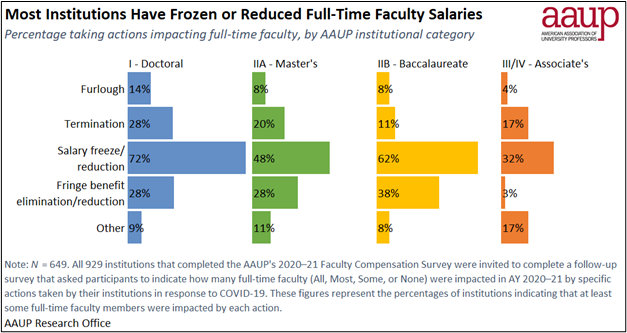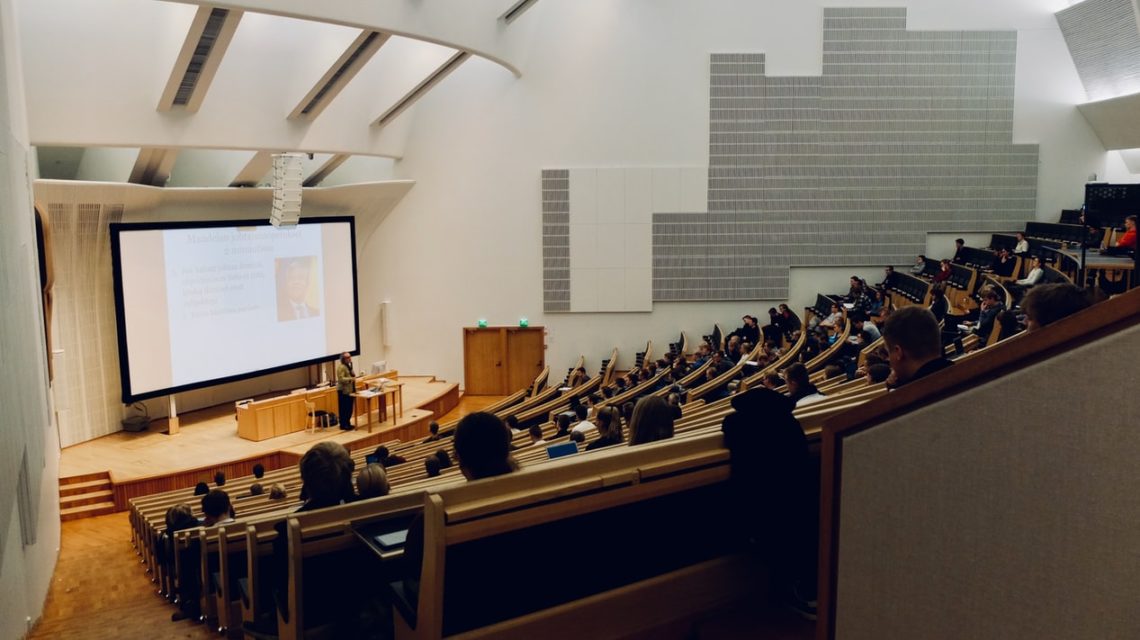
American Association of University Professors
2020-21 Faculty Compensation Survey Results
The AAUP’s 2020–21 Faculty Compensation Survey found that real wages for full-time faculty decreased for the first time since the Great Recession, and average wage growth for all ranks of full-time faculty was the lowest since the AAUP began tracking annual wage growth in 1972. After adjusting for inflation, real wages decreased at over two-thirds of colleges and universities. The number of full-time faculty decreased at over half of institutions.
To understand the ways in which institutions responded to the COVID-19 pandemic, the AAUP also asked participating institutions to identify how many faculty members–both tenure-line and non-tenure-track–were impacted by actions taken by institutions. US colleges and universities have taken a wide range of actions in response to financial difficulties stemming from the COVID-19 pandemic. At a time when many institutions were already struggling to balance their budgets, many lowered their expenditures by implementing hiring freezes, salary cuts, fringe benefit cuts, furloughs, and layoffs. The results of the AAUP’s 2020–21 Faculty Compensation Survey highlight the prevalence of such actions and how they have affected faculty members

Data collection for the AAUP’s 2020–21 Faculty Compensation Survey concluded in March, with 929 US colleges and universities providing employment data for nearly 380,000 full-time faculty members as well as senior administrators at nearly 600 institutions. In addition to full-time faculty employment data, institutions reported data for over 100,000 part-time faculty members who were employed in the prior academic year (2019–20). Data on part-time faculty were collected for the prior academic year, 2019–20, to ensure that institutions could provide complete data records.
Key Findings on Full-time Faculty Salary Data
- Average salaries increased 1.0 percent. This is the smallest increase on record since the AAUP began tracking this measure in 1972.
- After adjusting for inflation, real average salaries decreased 0.4 percent. After adjusting for inflation (the Consumer Price Index, or CPI, increased 1.4 percent in 2020), real wages decreased for the first time since the 2011–12 academic year.
- For doctoral institutions, average salaries increased 0.6 percent. After adjusting for inflation, real wages decreased 0.8 percent at doctoral institutions.
- For master’s and baccalaureate institutions, average salaries increased 0.8 percent and 0.1 percent, respectively. After adjusting for inflation, real wages decreased 0.6 percent and 1.3 percent, respectively.
- For associate’s institutions with faculty ranking systems, average salaries increased 1.7 percent, an increase of 0.3 percent in real terms. For associate’s institutions without faculty ranking systems, average salaries decreased 2.7 percent, a decrease of 4.1 percent after adjusting for inflation.
- Average salaries decreased at 42 percent of colleges and universities surveyed. Real wages decreased at 68 percent of colleges and universities after adjusting for inflation.
- Average salary growth varied by institutional control and religious affiliation. Average salaries increased 1.1 percent among public and private religiously affiliated colleges and universities, while average salaries among private independent institutions increased 0.2 percent.
Key Findings on Institutions’ Responses to the COVID-19 Pandemic

- Nearly 60 percent implemented salary freezes or reductions.
- About 30 percent eliminated or reduced some form of fringe benefits.
- Over 5 percent did not reappoint or terminated contracts for at least some tenure-line faculty.
- Over 20 percent did not renew contracts or terminated contracts for at least some non-tenure-track faculty.
- Almost 10 percent implemented furloughs for at least some faculty.
- Over 50 percent took some other action for tenure-line faculty. The most common action described was some type of early retirement program.
- Almost 30 percent took some other action for non-tenure-line faculty.
- Almost 50 percent implemented tenure-clock modifications for at least some tenure-track faculty.
Complete analyses and discussion of the impact of the COVID–19 pandemic on faculty members and other results from this year’s survey will be presented in the upcoming Annual Report on the Economic Status of the Profession, to be released in May. Although part-time faculty have surely been disproportionally impacted by the COVID–19 pandemic, data on part-time faculty were collected for the prior academic year, 2019–20, thus precluding in-depth analysis of how part-time faculty have been impacted this year. In general, institutions cannot provide employment data on part-time faculty until the end of the academic year.
Key Findings on the Number of Full-time Faculty Members
The number of full-time faculty members did not change significantly from last year. However, there was considerable variation with each institution type.
- The number of full-time faculty members decreased at 62 percent of institutions overall.
- At 26 percent of institutions, the number of full-time faculty members decreased at least 5 percent.
- The number of full-time faculty members decreased 0.3 percent overall.
- There was a small increase in full-time faculty members at doctoral institutions, and more substantial decreases at all other institution types. The number of full-time faculty members increased 0.8 percent at doctoral institutions, decreased 2.2 percent at master’s institutions, decreased 1.6 percent at baccalaureate institutions, and decreased 3.1 percent at associate’s institutions.
- The number of full-time faculty increased very slightly at public institutions and dropped at other institution types. The number of full-time faculty members increased 0.1 percent at public institutions, decreased 0.6 percent at private independent institutions, and decreased 2.4 percent at private religiously affiliated institutions.
The AAUP 2020–21 Faculty Compensation Survey results include two tables presenting annual full-time faculty salary growth by rank in both nominal and real terms from 1972 to the present, eighteen summary tables that allow for comparisons among different categories of colleges and universities, and three institution-specific appendices that provide average pay and benefits data for each participating institution.
Data Components Now Available:
- Salary differences by institutional category, control, affiliation, and region. [Survey Report Tables 1, 2, 4, and 5]
- Gender differences. [Survey Report Tables 3, 6, and 7]
- Retirement benefits. [Survey Report Table 8]
- Medical benefits. [Survey Report Table 9]
- Dependent tuition benefits. [Survey Report Table 10]
- Administrator salaries. [Survey Report Tables 11, 12, 13, and 14]
- Part-time faculty pay (2019–20). [Survey Report Table 15]
- Part-time faculty benefits (2019–20). [Survey Report Table 16]
Download survey tables
Download appendices
Important: The appendices are designed to be viewed as two-page spreads. In order to view the appendices as a spread, please download the PDF and reopen it after saving.











